One month ago I sowed most of my Lophophora seed for this season and thought I would post some pictures of the minuscule seedlings, only a couple of weeks old.
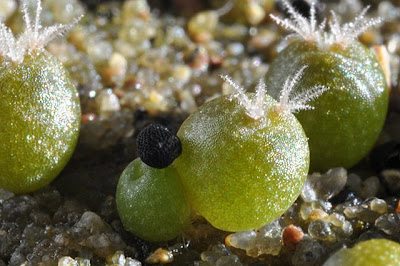
Lophophora williamsii seedlings (VM 534k; El Oso, Coahuila, Mexico)
I again bought seeds originating from the L. williamsii population in El Oso, Coahuila as I'm fascinated with the plants described in the booklet The genus Lophophora – Kaktusy Special 2, 2005 - allegedly this variety forms massive clusters with individual heads measuring up to 15 cm in diameter. The two seedlings in the center front of the above photo have grown from the same seed.
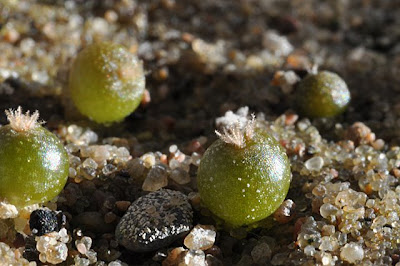
Lophophora decipiens sensu Steven Brack
For a long time I have wanted to grow the Lophophora decipiens offered in the Mesa Garden seed catalog – the plants are alluringly described as “powdery grey”. I have started L. decipiens seeds from Mesa Garden once before but ended up killing off most of the seedlings – to be on the safe side I ordered 100 seeds this time and are going to start them in several, separate batches ;-)
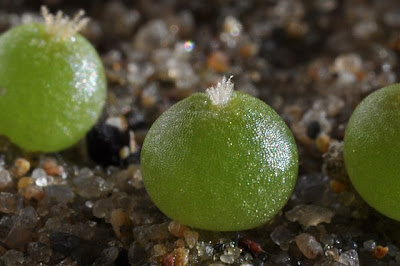
Lophophora fricii seedlings (KS 198; Viesca, Coahuila, Mexico)
I'm growing increasingly enchanted with Lophophora fricii but don't really have any mature specimens of this interesting species (except one plant that is almost of flowering size). To amend this I'm starting batches of Lophophora fricii from seed on a regular basis.
.jpg)
Lophophora williamsii seedlings (SB 418; Presidio County, Texas)
The L. williamsii plants from Presidio County, Texas represent the northernmost form of L. williamsii, also known as Lophophora williamsii var. echinata, and is a self-evident candidate for growing in the coldhouse.
Tuesday, May 12, 2009
Lophophora seedling pictures
Thursday, May 07, 2009
Lophophora diffusa swelling with water, time-lapse video
I'm keeping my plants completely dry during their winter dormancy and consequently they are rather flaccid come spring. The following time-lapse video shows a couple of my larger Lophophora diffusa plants growing turgid after having their first drink of water in several months.
In a fit of thoughtlessness I also watered the Bowiea volubilis visible in the background. This plant also started to expand generating visual “noise” that makes it harder to see exactly what moves when and where. To amend this mistake I inserted the white markers that act as fixpoints showing how much the cactus will have expanded by the time the video ends.
The pictures used for the time-lapse video were taken over a period of 88 hours starting March 6, 2009 in the afternoon through March 10 in the morning. A picture was taken every 15 minuttes giving a total of 352 photos; these are played back at 24 frames per second resulting in a video lasting slightly less than 15 seconds. Another piece of technical trivia is that each second of the time-lapse video corresponds to 6 hours real-time.
The pictures used for the high-definition (1280x720) version of the video above were cropped to obtain the 16:9 aspect ratio. A time-lapse video based on the uncropped and unmanipulated photos (without white markers) is shown below.
The swelling of the plants is not as evident as I had hoped for so I might try doing another “swelling with water” time-lapse video again next year – this time starring some of the plants from my coldhouse (as they are drought dormant for a longer time than my windowsill grown plants). Also the flickering, caused by the shifting light conditions during the day, is a bit disturbing. If I do a video like this again I'll see if I can avoid ambient light completely.
Tuesday, May 05, 2009
The Barcelona Cactus Garden – Jardins de Mossèn Costa i Llobera
As mentioned in the previous post I recently spent some time in Barcelona, Spain.
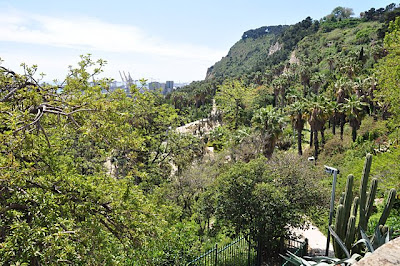
Panoramic view of Jardins de Mossèn Costa i Llobera
I had been looking especially forward to visiting the cactus garden, Jardins de Mossèn Costa i Llobera, located on the steep slopes of Mount Montjuïc that face the Mediterranean Sea and overlooked by the Montjuïc Castle (its hard to beat a location like that!), but when we arrived at the garden it was closed. We checked various signs and posters that all claimed that the garden should have opened a couple of hours prior to our arrival but all gates were locked. While I was standing sulking and disgruntled my entrepreneurial girlfriend had scanned the area and located a hole in the fence and through we went;-)

Ferocactus glaucescens flowers and a snail

A stand of Ferocactus glaucescens
It was a great experience wandering around the deserted garden – at first we lurked about, halfway expecting to be thrown out any minute, but nothing happened and soon we just enjoyed this calm and secluded cactus haven located so close to the hustle and bustle of the city.

Budding Ferocactus stainesii

Group of large Echinocactus grusonii
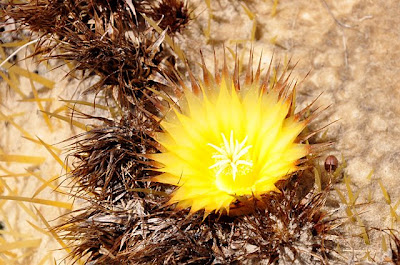
Echinocactus grusonii flower, close-up

Flowering Cleistocactus strausii
We never found an explanation for why the park was closed. Most of the park looked well tended for and ready to receive visitors but some of the more remote areas of the park had entered into a state of “lush decay” and a few foot paths were even blocked by plants.
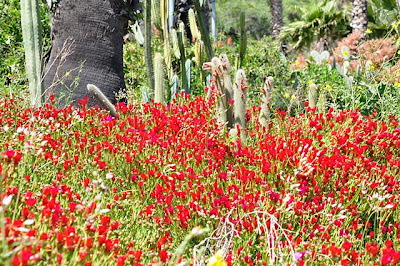
Lush decay

Blocked pathway
Later, when visiting Montjuïc Castle, I noticed a jogger crossing the cactus garden down below and leaving it through a different hole in the fence. Maybe the holes are an unofficial way of keeping a closed park open ;-)
If you're in Barcelona the park is definitely worth a visit – if you can find a way in ;-)
The video above shows a panoramic view of the central bed of the Barcelona Cactus Garden, Jardins de Mossèn Costa i Llobera. The bed features a group of massive Echinocactus grusonii (Golden Barrel Cactus) in the foreground - I have seen these described elsewhere as "clusters of round cactus that resemble a colony of alien eggs just about to hatch" ;-)
Monday, May 04, 2009
The Botanical Garden of Barcelona – El Jardí Botànic de Barcelona
I spent the last week of April vacationing in Barcelona, Spain and of course had to visit the botanical garden (even though I later had to spend hours and hours shopping and browsing shoe stores to be granted indulgence for spending a day among plants on Mount Montjuïc ;-)
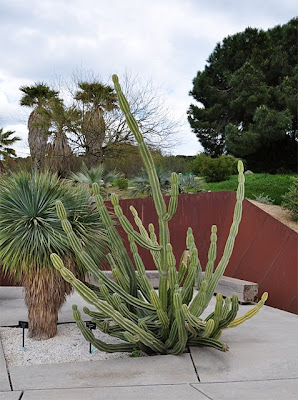
Cereus hildmannianus (hedge cactus / queen of the night)
The botanical garden of Barcelona was opened on April 18, 1999 so most of the plants are still quite young – the garden is worth a visit today but has the potential to become an absolutely amazing garden in a generation or two when the plants mature. The main focus is on plants from the Mediterranean climate regions (the homoclimatic zones of California, Chile, the Mediterranean basin, South Africa, and Southern Australia) so cacti are not predominant.
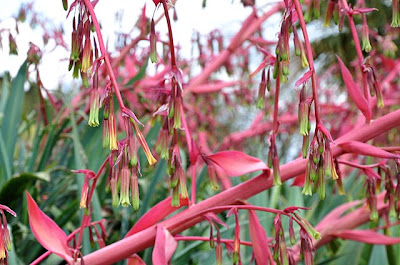
Beschorneria yuccoides flowers
Still you can find lots of interesting succulents like the stand of Beschorneria yuccoides (Mexican Lily, Red-hot poker), a stemless plant with an impressive bright red inflorescence ranging from 1 to 1.8 meter long.

Beschorneria yuccoides (Mexican Lily) stand
Speaking of fantastic inflorescences I also have to mention the Furcraea bedinghausii that flowered during our visit.

Furcraea bedinghausii flower, close-up

Furcraea bedinghausii inflorescence

Flowering Furcraea bedinghausii
The garden is situated next to the stadium, Estadi Olímpic de Montjuïc, that generates a lot of noise when a game is on. It was a slightly weird experience when the peaceful garden suddenly buzzed with the singing and shouting from the stadium.

Estadi Olímpic de Montjuïc as seen from the botanical garden
Actually two botanical gardens are located on Montjuïc. The construction work done in relation with the Olympic facilities built in 1986 seriously affected the stability of the Historic Botanical Garden and it was decided to build a new one (the one we visited). We tried to locate the historic garden, without luck (it was said to be located on the opposite side of the stadium from the new garden, but we couldn't locate it with certainty... we found what looked like an old park on some extremely steep slopes, though).
You can read more about the Botanical Garden of Barcelona at their website. If in Barcelona, make sure to also visit the Cactus Garden, Jardins de Mossèn Costa i Llobera.
All Time Most Popular Posts
-
Lophophora williamsii (peyote) populations have diminished in large areas of South Texas where peyoteros harvest the cactus for ceremonial ...
-
On various occasions I've been asked what growing media I'm using for my cactus plants. I don't have a set soil mix recipe as su...
-
Below is a list of retailers/nurseries selling cactus seed and plants. I've only listed vendors I've done business with. If you ar...
-
Most cacti are easily grown from seed - and with a little patience and care they can be grown into beautiful plants. Lophophora williamsi...
-
In last month’s post on the troubled Texan peyoteros I referred to Anderson’s article on the peyote situation in Texas. Given the importanc...
-
Yet another slightly off topic and probably not entirely politically correct post, but I couldn’t help noticing the similarity of my monstr...
-
Flowering stand of San Pedro cacti (Trichocereus pachanoi) To me the main draw of the San Pedro cactus ( Trichocereus pachanoi (syn. Ech...
-
In the June 2008 issue of the Cactus & Co magazine Jaroslav Šnicer, Jaroslav Bohata, and Vojtěch Myšák described a new Lophophora spec...
-
There seems to be an increased focus on the alarming Texas peyote situation. A couple of weeks ago the Houston Press published a mournful, i...
-
I spent two weeks working in Delhi, India during January. I had one weekend off and had planned to spend it in Delhi at my own leisure, but ...


















